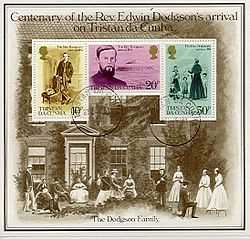Lewis Carroll, Victorian author of the well-known children's stories Alice in Wonderland and Through the Looking Glass, also wrote a less well-known book entitled Sylvie and Bruno, published in 1899. A poem, The Mad Gardener's Song, appears in the book with an albatross verse:
He thought he saw an Albatross
That fluttered round the lamp:
He looked again, and found it was a Penny-Postage Stamp.
'You'd best be getting home,' he said:
'The nights are very damp!'
Lewis Carroll was the pen name of Charles Lutwidge Dodgson, who was an English author, mathematician, logician, Anglican deacon and photographer. His brother, the Reverend Edwin Heron Dodgson, was the resident priest on Tristan da Cunha in the South Atlantic from 1880 to 1884 and again from 1886 to 1889. Assuredly Edwin would have spoken to his brother Charles about his two sojourns on Tristan, who may well have learnt about albatrosses from him.
Click here to view a page of a letter from Carroll to his illustrator, suggesting along with an amusing sketch quite how an albatross could turn into a postage stamp.

Postage stamps issued in 1981 by Tristan da Cunha
to mark the centenary of Edwin Dodgson's arrival on the islands

The Tristan Albatross Diomedea dabbenena was likely extinct on the main island of Tristan by the end of the 19th century. However, two other species still breed on the island: the Atlantic Yellow-nosed Thalassarche chlororhynchos and the Sooty Phoebetria fusca Albatrosses. If Lewis Carroll did learn about albatrosses from his brother one could wonder which of the three species (if any) he intended to be illustrated in Sylvie and Bruno.
Click here to read the whole poem: it's quite fun!
John Cooper, ACAP Information Officer, 28 August 2011

 Français
Français  English
English  Español
Español